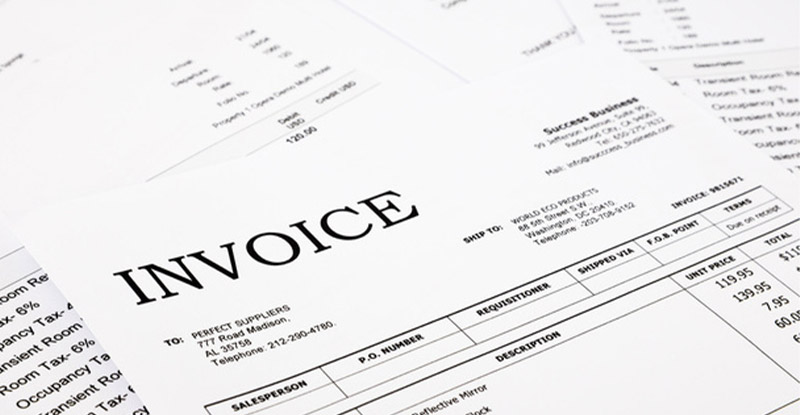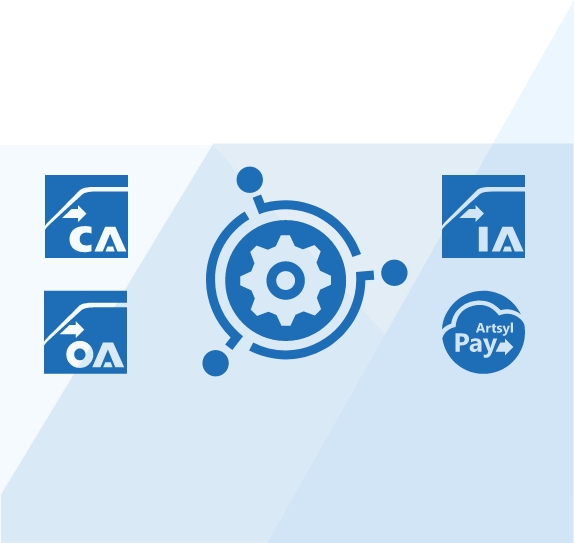As a CFO of an organization, you understand the importance of timely payment of invoices. Paying invoices on time helps maintain a healthy relationship between your company and suppliers and ensures smooth cash flow management. Despite this, there are so many payment options available that it’s easy to feel overwhelmed when deciding which method to use for paying invoices. In this blog post, we’ll discuss various payment options organizations have to pay their invoices.

Ready to streamline your invoice payments and unlock a world of accuracy and convenience?
Explore the benefits of InvoiceAction today and experience hassle-free invoice management like never before!
Invoice Meaning in Accounting
As a key component of accounting, invoices are critical documents that are evidence of a sale. In basic terms, invoices are bills or receipts a seller provides to a buyer. They outline the goods or services supplied and specify their monetary value.
Invoices contain various essential information, including the names of the seller and buyer, a unique invoice number, the date of the transaction, and the payment terms. Invoices serve as legal documentation and are often used as proof of payment for taxes or audits.
Understanding the meaning of invoices in accounting is essential for businesses to document financial transactions and maintain accurate records accurately.
Invoice Automation Software
Related Videos
How to Pay Invoice: What Information Is Provided?
When you receive an invoice, it typically includes important information necessary for payment and record-keeping purposes. Here are some common details you can expect to find on an invoice:
- Invoice number: A unique identifier assigned to the invoice for tracking and reference purposes. This number is helpful when communicating with the vendor or when organizing your records.
- Invoice date: The date when the invoice was issued. It indicates when the payment is due and helps you track the timeline for payment.
- Due date: The date by which you must pay invoice. It is important to adhere to this deadline to avoid late fees or penalties.
- Vendor information: The name, address, and contact details of the vendor or business providing the goods or services. This information is necessary for accurate payment processing and communication.
- Your information: Your name, address, and contact details. This ensures the invoice is properly addressed and enables the vendor to contact you if needed.
- Description of goods or services: A detailed breakdown of the goods or services provided. It includes quantities, item descriptions, unit prices, and applicable taxes or discounts.
- The total amount you need to pay invoice for, including any taxes or additional charges. It is essential to verify this amount to ensure accurate payment.
- Invoice payment instructions: Details on how to pay invoice, including accepted payment methods, bank account information for wire transfers, and any specific instructions or references to include when making the payment.
- Terms and conditions: Any additional terms and conditions associated with the invoice, such as late payment fees, payment terms, or refund policies. It is important to review and understand these terms to ensure compliance.
- Remittance information includes the preferred method to provide proof of payment, such as remittance advice or payment confirmation. It helps the vendor reconcile your payment with the corresponding invoice.
It’s important to carefully review the information on the invoice and cross-reference it with your purchase orders or agreements. If you have any questions or notice any discrepancies, it is recommended to contact the vendor or business for clarification before making the payment.
Discover how ArtsylPay can simplify your payment processes, save you valuable time, and ensure accurate and timely payments. Say goodbye to manual invoice handling and unlock the power of automation!
Book a demo now
How to Pay Invoice: Industry-Specific Methods
Different industries may have specific payment methods based on their unique requirements and practices. Here are some industry-specific methods commonly used for invoice payments.
Construction Industry
In construction projects, payments are often made in stages based on the completion of specific milestones or phases. These progress payments may be outlined in the contract or agreement.
The client may retain a percentage of the total invoice amount until the project is completed to their satisfaction. The retained amount is usually released after a specified period, such as the defect liability period.
Freelancers and Creative Professionals
Freelancers and creative professionals often use payment platforms like PayPal, Stripe or specialized platforms like Upwork or Fiverr. These platforms offer secure payment processing and provide additional project management and dispute resolution features.
Retail and E-commerce
Retail businesses use POS systems to process payments at the physical location. Customers can pay using various methods, such as credit/debit cards, cash, mobile payments, or digital wallets.
E-commerce businesses typically integrate online payment gateways into their websites, such as PayPal, Stripe, or other payment processors. This enables customers to make secure online payments using different payment methods.
Professional Services
Professional service providers, such as lawyers, consultants, or accountants, often invoice based on billable hours. The invoice includes a breakdown of the hours worked, the hourly rate, and any additional expenses incurred.
In some cases, clients may enter into retainer agreements, where they pay a predetermined fee upfront to retain the services of the professional over a specified period. Invoices may be generated based on the agreed retainer terms.
Subscription-Based Services
Subscription-based businesses, such as software as a service (SaaS) companies or membership organizations, often set up recurring payment arrangements. Customers provide their payment details once, and the agreed-upon amount is automatically charged regularly.
Wholesale and Manufacturing
In wholesale and manufacturing industries, businesses often establish trade credit arrangements with suppliers. Purchase orders are generated, and payment terms are agreed upon, allowing for the shipment of goods before payment is due.
It’s important to note that these methods can vary within each industry, and businesses may have their own specific payment preferences. It’s always advisable to communicate with the relevant parties and follow the payment instructions on the invoice or as agreed upon in contracts or agreements.
Want to take control of your invoice payments and boost your financial efficiency? Dive into the game-changing features of ArtsylPay and revolutionize how you pay invoices. Don’t miss out on this opportunity!
Book a demo now
How to Pay Invoices with Direct Bank Transfers
Direct bank transfer is one of the most popular payment options for organizations. It enables you to transfer funds directly from your bank account to your supplier’s account. Typically, you must provide your supplier with your bank account details and the recipient’s authorised bank details.
Direct bank transfers are reliable and secure, ensuring your payment safely reaches your supplier.
How to Pay Invoices with Credit Cards:
Credit cards are another popular payment option for organizations. Paying invoices through credit cards offers convenience, speed, and flexibility. You can make invoice payments anytime and from anywhere.
Moreover, many credit card companies offer reward points, cashback, and other benefits that can add to significant savings over time.
How to Pay Invoice with Electronic Payment Systems
Electronic payment systems such as ArtsylPay, PayPal, Stripe, and Square have emerged as inexpensive and convenient ways to pay invoices. These systems offer a secure and fast way to transfer funds electronically.
With electronic payment systems, you don’t have to worry about the security risks of sharing your bank details. Moreover, many electronic payment systems offer features like invoicing, recurring payments, and fraud protection.
Explore the incredible advantages of ArtsylPay and unleash the potential of seamless invoice payments.
From enhanced accuracy to streamlined workflows, our platform will transform how you handle invoices.
Get started now!
Book a demo now
How to Pay Invoice with Checks
While checks are becoming less and less common as a payment method, they’re still an option for those who prefer them. You can either mail the check to your supplier or deliver it in person. However, checks can be time-consuming since you need to write and mail the check. Additionally, checks can be lost in the mail, resulting in delays and extra fees.
How to Pay Invoice with Automated Clearing House Transfers
Automated Clearing House (ACH) transfers are a convenient and secure option for making electronic payments. ACH transfers allow you to transfer funds directly into your supplier’s bank account.
Unlike wire transfers, ACH transfers are less expensive, making them affordable. However, if you need to make an urgent payment, ACH transfers may not be the fastest option, as payments can take up to several days to process.
Final Thoughts: Choosing How to Pay Invoice
As a CFO, you must consider various factors when choosing the right payment method for your organization. Each payment option has pros and cons, so assessing your organisation’s needs is essential before selecting a payment method.
Direct bank transfers, credit cards, electronic payment systems, checks, and ACH transfers offer various benefits. Understanding these options lets you make informed decisions about your payment needs.
Are you tired of juggling multiple invoices and missing payment deadlines? Discover how ArtsylPay can empower you with automated reminders, effortless payment tracking, and unparalleled peace of mind. Don’t wait. Take charge of your invoice payments today!
Book a demo now
FAQ
Can I pay an invoice in instalments?
The possibility of paying an invoice in instalments depends on the agreement between you and the recipient. Some businesses may offer instalment plans or payment arrangements for large invoices or long-term projects. Discussing this option with the recipient before making any assumptions or commitments is important.
How do I ensure the security of my payment information when I pay invoice?
To ensure the security of your payment information, follow these best practices:
- Verify the legitimacy of the recipient or business before providing any payment details.
- Ensure you are on a secure website (look for «https» in the URL) when entering payment information online.
- Keep your computer and devices protected with up-to-date antivirus software.
- Avoid sharing payment information over unsecured Wi-Fi networks.
- Monitor your bank and credit card statements for unauthorized charges.
Can I request an invoice to be sent electronically?
Yes, you can request to receive an invoice electronically. Many businesses offer electronic invoicing options via email or online portals. This allows for faster and more efficient processing of invoices.
What should I do if there is a discrepancy or issue with the invoice?
If you notice a discrepancy or issue with the invoice, promptly communicating with the sender is important. Contact them to discuss the problem and provide any necessary documentation or explanation. This will help resolve the issue and ensure the payment process proceeds smoothly.
Is it necessary to keep a record of paid invoices?
Yes, it is essential to maintain a record of paid invoices for your own reference and tax purposes. This can help you track your expenses, reconcile accounts, and provide evidence of payments made. Keep copies of invoices, payment receipts, and related documentation securely and organized.



 Organizational Success Through Strategic Financial Management: The Essential Role of a Financial Manager
Organizational Success Through Strategic Financial Management: The Essential Role of a Financial Manager What is Invoice Factoring?
What is Invoice Factoring? Purchase Order vs. Sales Order: What is the Difference?
Purchase Order vs. Sales Order: What is the Difference? Understanding Payment Analytics and Payment Processing
Understanding Payment Analytics and Payment Processing Accounts Payable Automation and Payment Optimization
Accounts Payable Automation and Payment Optimization Payment Processing: Security, Compliance, and Fraud Prevention
Payment Processing: Security, Compliance, and Fraud Prevention
